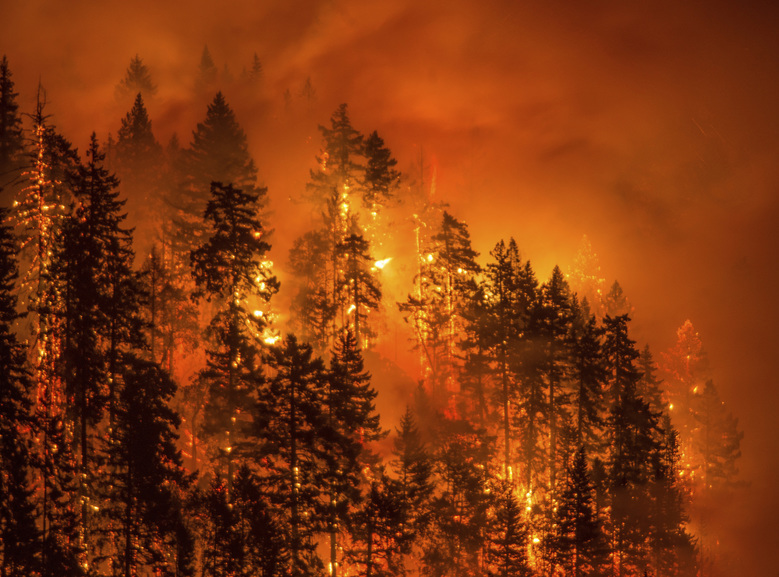Our previous blog post, which linked to a news clip describing a Joint Legislative Audit and Review Committee report on the cost of fighting wildfires in Washington, said the season extends “typically between May and September.” But as noted in a recent KING-TV story, “In Washington, wildfire season is year-round.”
So too it seems is the season for writing about wildfires.
Much of the current coverage is focused on California continuing to deal with its worst fire season on record. Local and national pieces, from a New York Times book review, to an article in Forbes, to a one-sided screed in the Seattle alternative weekly The Stranger, look at wildfires through a different lens. The provocative NY Times headline “Are the American West’s Wildfires Inevitable?” captures the thrust of many of these pieces, some of which are highly critical of logging and forest management. Their proffered “solutions” can range from “let it burn” to a call for more alternative energy use to reduce carbon and influence climate.
Among the things overlooked in some of the more pointed writings is any recognition of how appropriate forestland management can help reduce the incidence and severity of wildfires. As Shawn Regan writes in “Money to Burn: Wildfires are getting bigger and more costly, and federal policies aren’t helping” for the Property Environment Research Center:
“…environmental laws often prevent much-needed projects, such as selective thinning to mimic the effects of fire (which in some cases also provides lumber for commercial uses) and prescribed burns in which fires are intentionally set and controlled to manage vegetation.”
The article notes that in federal forests (though can also be true at the state and local level), such management practices are “usually accompanied with endless litigation by environmental groups seeking to halt them.”
Some of the articles critical of forest management practices attack the Resilient Federal Forests Act being considered by Congress, though the authors often tend to not let the specifics of the legislative proposal get in the way of political posturing. An effective rebuttal to one such invective was offered by Nick Smith, Executive Director of Healthy Forests, Healthy Communities. Here’s part of what he wrote in a letter to the editor of the Payson Roundup in Arizona:
“The Resilient Federal Forests Act gives the Forest Service new categorical exclusions to expedite treatments on forests that are at immediate risk of catastrophic wildfire, insects and disease…
“The bill does not mandate logging or any specific management activity. A forest project under the bill may use a number of tools — such as mechanized thinning and prescribed fire — that are appropriate to a given landscape, supported by science, and consistent with the existing forest plan.
“Your editorial suggests the bill will lead to the logging of ‘remaining, fire-resistant, old-growth trees.’ This is not true, and this political approach to forestry leads to arbitrary, one-size-fits all policies that tie the hands of federal land managers and prevents them from applying treatments that are right for the landscape. It’s why the Southwest has lost its forest infrastructure (mills, loggers, etc.), and exactly why restoring fire-prone forests has become so cost-prohibitive in the region.”
Some conservation organizations also are recognizing that practices like selective logging can lead to healthier forestlands and ensure forests are “more resistant to fire, disease and climate change.” A story in U.S. News earlier this year reported on how the Nature Conservancy is working with Washington’s Central Cascades private forestland owners on a restoration thinning project “aimed at preventing wildfires and restoring forest health.” According to Brian Mize of the Nature Conservancy:
“What we’re trying to show is that this is sustainable. You can make a profit here and treat a lot of these forests that need to be treated. Just doing nothing, I think we know what the results are going to be, especially in the context of climate change.”
WFPA was founded more than 100 years ago (in 1908) to protect private forestland from wildfire. Experience and scientific research have shown that proactively managing forests can improve and protect ecosystem health and enhance habitat quality. Sustainable forestry as practiced by WFPA members and others can help reduce the incidence and severity of fires while also generating jobs, a continuous supply of wood for products we use daily, and many other benefits including protection of habitat for animals and fish, recreation opportunities, and green spaces we all enjoy.
We can’t eliminate all the risks of wildfires. But when privately owned, state, and federally managed forests are on the same page for applying practices that promote forest health, the conditions needed for catastrophic fire can in many cases be sharply curtailed or eliminated.
